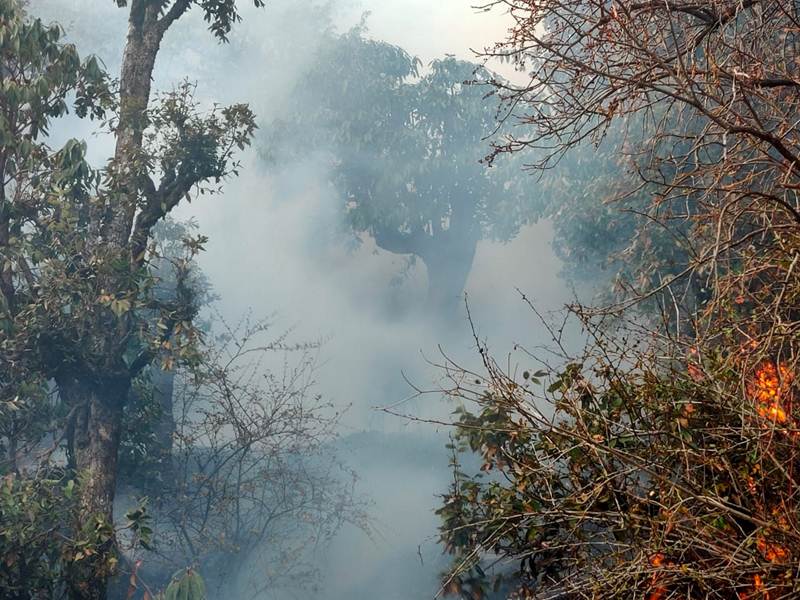Dehradun, Uttarakhand
Amid the second wave of the COVID19 pandemic, as coronavirus spreads like wildfire in the country, Uttarakhand’s forests are also on fire.
Since January 1 this year, 2,537.65 hectares (ha) of forest area has been destroyed by at least 1,797 fire incidents in the Himalayan state, as recorded on the website of the Uttarakhand Forest Department. This gutted forest area is equivalent to 4,600 football grounds. Six people and 17 animals have lost their lives in these forest fires. Another 22 animals have been reportedly wounded. The total loss in monetary terms is estimated as Rs 6,477,300.
Uttarakhand is no stranger to forest fires. The onset of the fall-like conditions around February is ridden with anxieties for the state.
#uttarakhandforestfire
— Gaon Connection English (@GaonConnectionE) April 4, 2021
As per news reports, at four people and seven animals have died due to wildfires in #Uttarakhand
Video: Forest fire in Tehri Garhwal district
Credit: @megha_prakash pic.twitter.com/I1xXDcmPEU
As the trees in the Himalayan state shed leaves, humidity in the air comes down and the mercury begins to soar in the coming summer months, the state records a plethora of cases of forest fires.
Also Read: Nepal’s forest fires under control, but peak wildfire season has just begun
Such is the frequency of the forest fires in the months of February to June that the season has earned the infamy of being feared as the ‘season of fires’.
The situation this year is even more worrying because the peak time for forest fire — the months of May-June when temperature is highest – is yet to arrive.

“Three components factor in these forest fires — temperature, humidity and the biomass fuel in the form of dry leaves and branches that are found in the fall season,” district forest officer (DFO) Rajeev Dheeman told Gaon Connection.
“The first two components cannot be controlled immediately and are natural to a considerable extent but as part of our mechanism to control and prevent these fires, we try to segregate this biomass fuel in the forest areas before and during the ‘fire season’,” he added.
Dheeman also informed that fast blowing winds are another factor that intensifies the spread of these fires.

Meanwhile, talking about 36 fire incidents in Mussoorie, the DFO in the area told Gaon Connection that these forest fires are entirely humanmade. “People are careless and they do not understand the catastrophic damage that these fires are capable of causing. Spark from a casually thrown cigarette can burn down hundreds of hectares of forests,” Kehkasha Naseem said.
Climate change to blame?
The Himalayan state has a forest cover of over 38,000 square kilometres, which is almost 70 per cent of the total geographical area in the state. Forest fires that rage in the months between February and June not only destroy the green cover but also perish some of the richest ecosystems in the country.
Also Read: The Himalayan state is besieged by extreme floods and increased droughts
Experts blame the changing weather pattern and climate change for the rise in forest fires. Lack of winter rainfall may have a role to play.
According to the state’s weather department, from January to March this year, merely 10.9 millimetre (mm) of rainfall was recorded in the state as opposed to the normal rainfall of 54.9 mm in these three months. This is a marked decrease of almost 80 per cent of precipitation.
Uttarakhand HC took suo motu cognisance
Taking suo motu cognisance of the forest fires in the state, Uttarakhand High Court on April 6 summoned principal chief conservator of forests Rajiv Bhartari to inform about the preparedness of the forest department. The court also asked the official to explain what measures have been taken to quell the crisis as of now.

This happened a day after the Uttarakhand government reached out to the central government for its assistance in battling the forest fires. Chief Minister Tirath Singh Rawat held an emergency meeting of state government officials and also requested the Centre to provide helicopters and personnel to douse the fire.
In reply, Home Minister Amit Shah had posted on Twitter that he has been briefed about the situation by Rawat and that the orders have been issued to send the equipment and personnel needed.
According to the Chief Minister’s Office (CMO), more than 12,000 forest personnel have been deployed in the ongoing fire-fighting operations.
However, the fires still continue to rage on and hopes are pinned on the southwest monsoon that should help douse them.


















